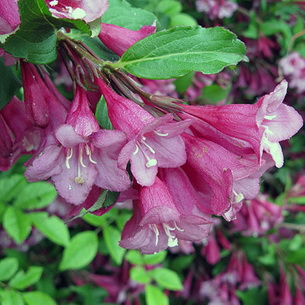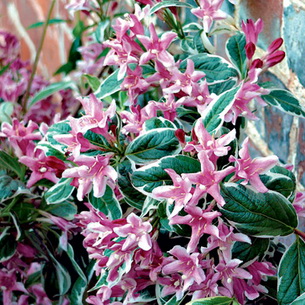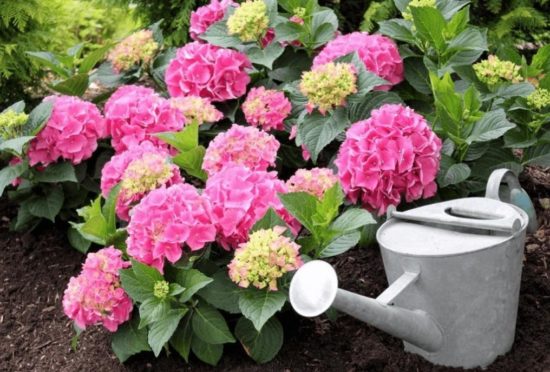Main types and varieties with photos and names
For gardeners of middle latitudes, weigela varieties are most suitable, which are resistant to frost. These include the species and varieties described below.
Early weigela, or weigela pleasant (Weigela praecox)
In natural conditions, it grows in the Far East. The bush reaches a height of about 200 centimeters. There is pubescence on the foliage surface. The crown is spherical. The outer part of the flowers is deep pink. Inflorescences consist of 2 or 3 flowers, while they grow on the lateral shoots of this year. It happens that the throat of the flower has a white-yellow color, in the buds the flowers are painted purple. Flowering begins in the last days of May and lasts from 10 to 30 days. The variegated variety of weigela variegated is of the greatest interest. On the surface of the green leaf plates there are specks of yellow color, in the summer they acquire a cream color.
Weigela flowering, or weigela florida (Weigela florida)
The bush reaches a height of 300 centimeters. There are 2 rows of hairs on the surface of the shoots. Short petiolate serrated leaf plates on the front side have pubescence located along the central vein, while on the seamy surface all veins have pubescence. The inflorescences consist of 3 or 4 flowers, painted in a deep pink color, which open in the last days of May. Flowering lasts approximately 20 days.
Popular forms:
- Weigela purple, or weigela red (Weigela Purpurea). The height of the bush is about 150 centimeters, there is a lush crown. The leaf plates are brownish-red in color, the bright pink flowers have a yellow throat. Bloom is observed in June and July. Nana Purpurea is very similar to weigela purple, but the shrub is smaller.
- Alba. It is a dwarf form. White flowers turn pink during wilting.
- Variegata. This form is very beautiful and the most frost-resistant. Has small leaves. The racemose inflorescences are composed of deep pink flowers.
- Weigela pink (Weigela florida Bunge). The outer surface of the flowers is carmine pink, while the inner surface is almost white.
- Weigela Victoria (Weigela florida Victoria). The height of the bush is about 100 centimeters. The foliage is brownish red, and the flowers are crimson.
Weigela hybrid (Weigela hybrida)
Has a spreading crown, lush flowering. The height of the bush is about 150 centimeters. Fragrant flowers have a funnel-shaped tubular shape, they can be part of loose inflorescences or be single. Depending on the variety, the color of the flowers can be pink, lilac, purple, white, violet-red.
Popular varieties:
- Bristol Ruby. The variety appeared in 1941 in the United States. The bush can reach a height of 250-300 centimeters, while the diameter of its crown is 350 centimeters. The leaves are deep green in color. The pink flowers have ruby-red edges, sometimes their center is colored orange. This fast growing plant begins to bloom in the last days of June.
- Red Prince. The variety was bred in the USA. A compact bush in height can reach 150 centimeters. Has a spreading crown, drooping branches. Bright red flowers look very beautiful against the background of green leaves.
Weigela middendorff (Weigela middendorffiana)
The height of the bush can vary from 100 to 150 centimeters. Ascending shoots. Large (3 to 4 centimeters) yellow flowers have orange spots in the throat. They are part of low-flowered inflorescences of 2-6 pieces or are single. Flowering is observed twice per season.
Also, quite often gardeners grow abundantly flowering weigela, pleasant weigela, early weigela, Japanese weigela, garden weigela, Maximovich weigela and Korean weigela.
Preparing weigela for winter
Weigela is a heat-loving shrub, and for the winter she needs a reliable shelter. Plants planted or transplanted this season, as well as young bushes up to 4 years old, especially need it.
Sanitary pruning
Unlike other trees and shrubs, weigela should be cut early enough - right after flowering, which usually falls in August.But if you did not manage to process the bush at this time, then prune in the second decade of September, about 3 weeks before the onset of the first cold weather. Remove all diseased, dried and poorly developed shoots, as well as root shoots, without shortening healthy branches - it is better to postpone this event until next season, otherwise you risk reducing the flowering of the bush. Lubricate places of large cuts (more than 1.5-2 cm in diameter) with garden varnish. Do not forget to disinfect the instrument before and after the procedure - to do this, wipe the blade with kerosene or alcohol, or ignite it over a fire.
Autumn feeding
In order for weigela to better endure the winter cold, it is necessary to provide it with a supply of nutrients. In the period until mid-September, add compost (4 kg / m 2), superphosphate (50 g / m 2), potassium chloride (30 g / m 2) to the trunk circle under a shallow digging. If you do not want to use mineral fertilizers, then they can be replaced with ash (200 g / m2). In the case of pruning, fertilizer can be applied immediately after it.
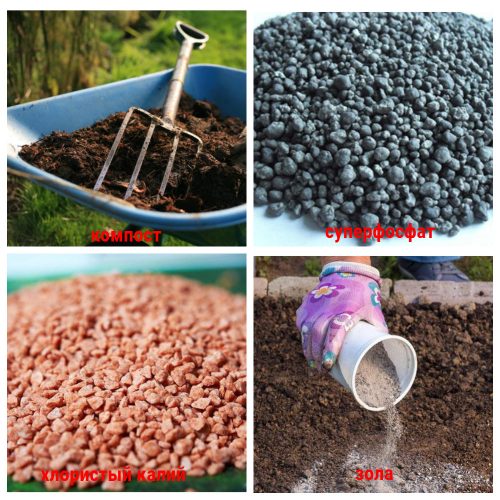
To improve the winter-hardy qualities of weigel, autumn feeding is required
Watering
In order to prevent freezing of the ground and provide the roots of the bush with a supply of water for the winter, at the end of September it is necessary to carry out water-charging irrigation at the rate of 20-30 liters per plant. But if the autumn was rainy, then there is no need for additional moisture.
Treatment of the near-barrel circle and construction of a shelter
- At the end of September, loosen the soil in the near-trunk circle, and spud the trunk to a height of 20-25 cm with soil brought from the garden. Then add a small (7-10 cm) layer of mulching material. Peat, humus, dry foliage are well suited.
- In the beginning - mid-October, after the onset of small (up to -3 o C) frosts, start preparing a winter shelter for your shrub. In practice, the following options are used:
- Frameless (horizontal):
- Lift the bush branches up and secure in a circle.
- Wrap the blank in burlap.
- Pour mulch into the trunk circle so that its layer reaches 20-30 cm.
- Bend the workpiece to the ground and secure.
- Pour another 15–20 cm of mulching material onto it.
- Tighten the mound from above with some breathable material: spunbond, lutrasil, agrotex, in extreme cases, roofing material or craft paper. It is undesirable to use a film, because during the spring thaws, a "greenhouse" can form inside the shelter and a large amount of moisture can accumulate.
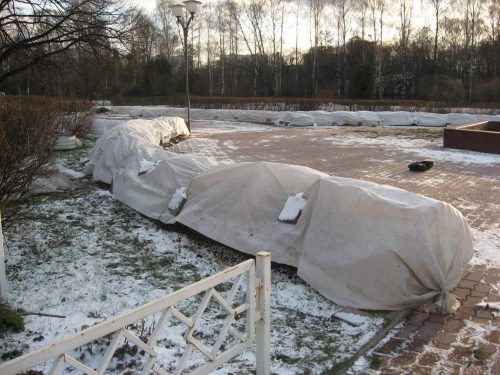
For sheltering weigels for the winter, it is advisable to use breathable
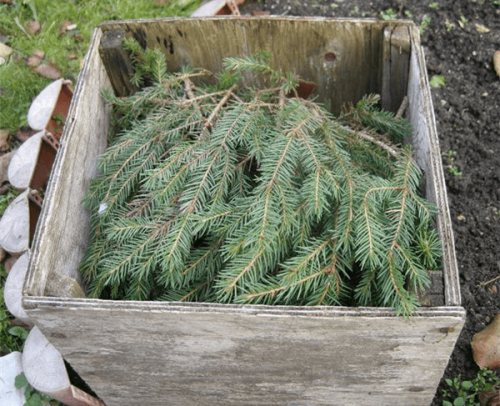
It is convenient to cover a small bush for the winter using a box with a removed bottom
Video: how to make a shelter from arcs
As you can see, it is not difficult to protect the weigela from the winter cold, it is enough just to prepare a sufficient amount of mulch and stock up on good covering material. Do all the work on time, and you will provide your green pet with health and proper development.
Weigela is an insanely decorative, brightly flowering shrub that quickly gained popularity among many flower growers, but some of them are quickly losing interest in the plant due to freezing in the winter.
Next, let's talk about what kind of care the shrub needs in the fall, how to properly prepare the weigela for winter, so that next season it will delight you with its beautiful rapid flowering.
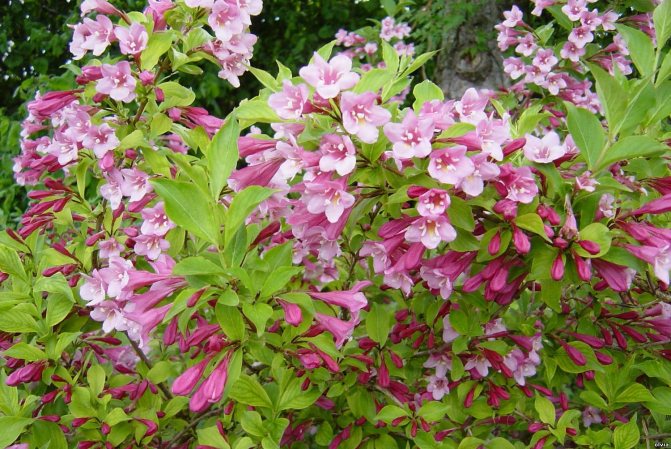
Description
In the wild, Cossack juniper can be found in any part of the Eurasian continent. The amazing flexibility of the character of the plant allows it to adapt to a wide variety of natural conditions, for example, in the southern mountains of Europe or in Siberia. This type of juniper is widespread in the lands of Asia Minor and the Caucasus.
According to biological data, the Cossack juniper, or as it is also called juniperus sabina in Latin, is a creeping dioecious plant species. Its dimensions generally increase in width, which results in a rather fluffy coniferous shrub.The root system is strong, easily adaptable to any soil composition.
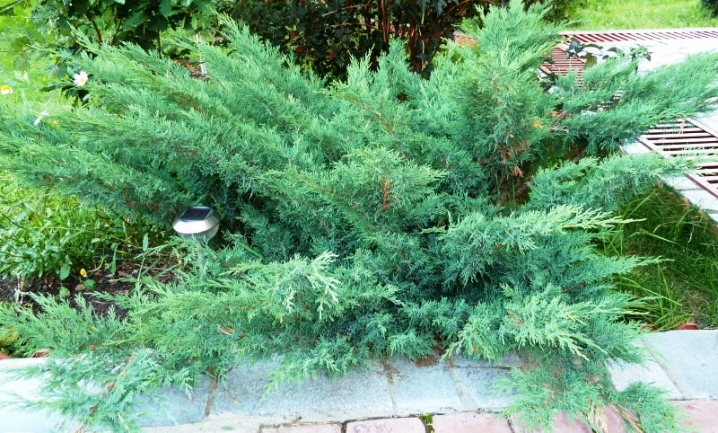
In the wild, there are specimens of this plant growing in the most unusual arboreal forms with a curved trunk. You can endlessly look at this uniqueness of a natural phenomenon.
The annual growth of the Cossack juniper averages 5-7 cm in length
This factor is important to consider when buying young seedlings. And thanks to its ability to create dense thickets from a number of growing bushes, it will turn out to use the coniferous Cossack juniper as an imitation of wildlife in the home garden or create decorative fences
The maximum height of the shrub reaches 4 m.
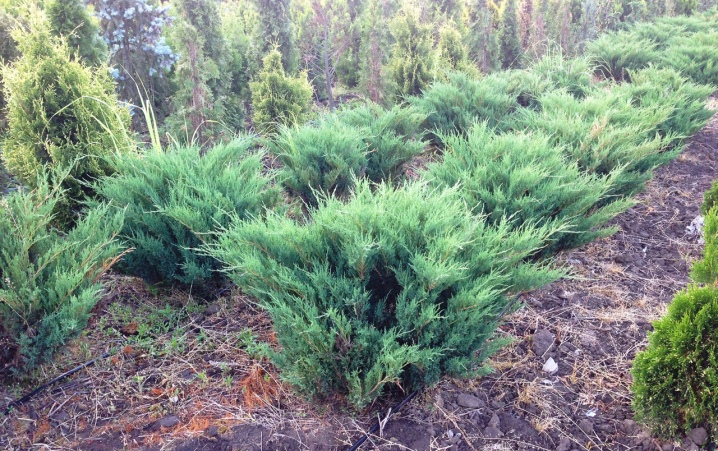
It is worth noting that each element of the structure of the Cossack juniper is considered special, and even the bark. It has a natural brown color, reminiscent of the trunk of a large tree. During the growth of the juniper, uneven flaking of pieces of bark occurs, where subsequently a reddish tint occurs. Very bright brown spots are visible on the branches of old coniferous bushes, which gives the juniper a pronounced picturesqueness and originality. Novice gardeners should know that the Cossack juniper is divided into 2 coniferous species.
- Young look. Above the central vein, softened processes of needles with a bluish scale and blunt tips grow.
- Adult look. In appearance, the needles resemble a kind of dark green scales, and in some places an olive shade is visible.

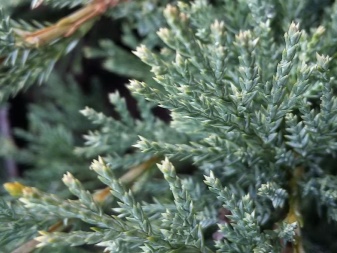
As for the fruits of the Cossack juniper, they cannot be called outstanding. The cones grow very small. Their maximum length reaches 0.5 mm. The shape of the fruit is elongated, the color is blackish, there is a bluish bloom on the surface of the cones. Due to their small size, they easily hide in the needles, and it is almost impossible to distinguish them with the naked eye on dense juniper branches.
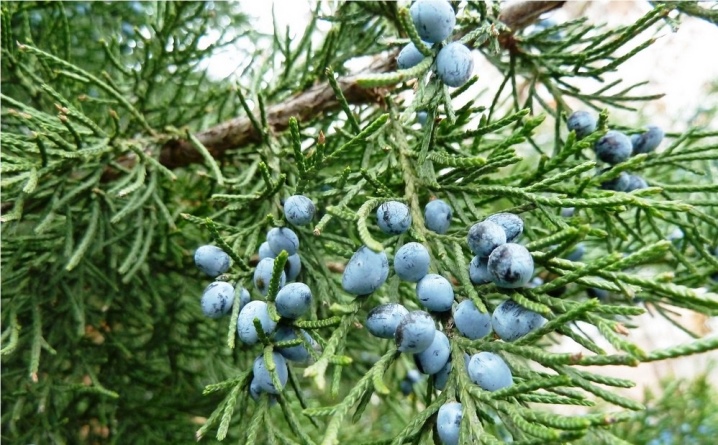
The seeds in the cone berries ripen by the end of the fall or spring of the next year. But the fertile period in the described species of conifers begins only with the onset of 8 years. Among many coniferous representatives, the Cossack juniper is determined by its smell. It is impossible to confuse such a sharp aroma with other smells. It arises in the process of rubbing coniferous branches with shoots in the hands. In particular, the unpleasant smell is caused by the essential oil, which determines the natural origin of the bush.
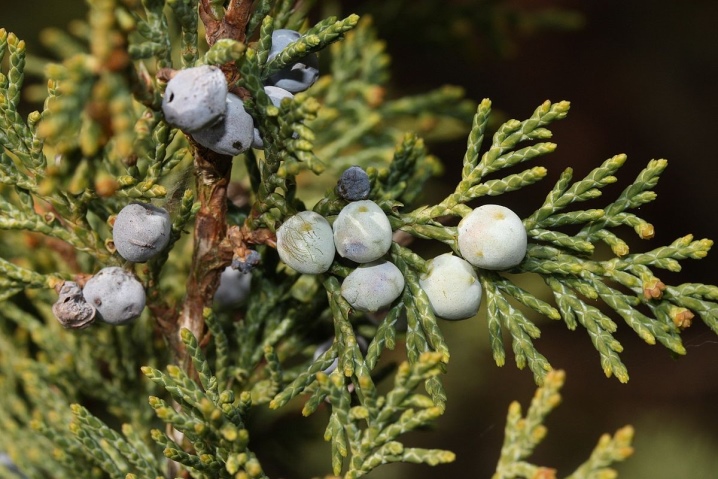
Peculiarities
Weigela belongs to the Honeysuckle family and is represented exclusively by shrub species. It got its name from the name of the discoverer Christian Weigel, who was engaged in research in the field:
- botany;
- chemistry;
- pharmacology.
In total, there are 15 species of deciduous shrub in the genus. But 8 of them are considered not graceful enough for garden cultivation. The same 7 varieties (and varieties created on their basis), which are selected by breeders, along with beauty, are also distinguished by unpretentiousness.
It is noted that weigela needs moisture and develops well when shaded. The formation of stolons is not typical. The leaf blades are of the opposite petiole type. Stipules are absent. The flowers reach 0.05 m in length. There are varieties of culture with single or with several flowers connected in loose inflorescences.
It should be noted that at the stage of flowering, the saturation of the colors only grows. Weigela fruits look like bolls with a pair of valves. Small seeds are located inside. The height of cultivated plant varieties ranges from 0.6 to 2 m. For information: in the wild, it is sometimes up to 2.5-3 m.
The best varieties of panicle hydrangea for the Moscow region: photo and description
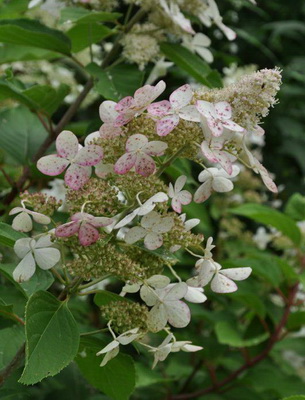
‘Brussels Lace’
The height of the bush is 2 m. The inflorescence is up to 30 cm long, conical in shape, the flowers are fertile and sterile. White, later turning pink. Blooms until October.
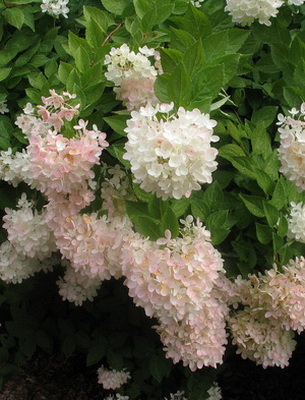
'Grandiflora'
The height of the bush is 2-3 m. The inflorescence is a wide cone, 20-30 cm long.The flowers of this variety of paniculate hydrangea, suitable for the Moscow region, are sterile, creamy white, then pink. Blooms until October.
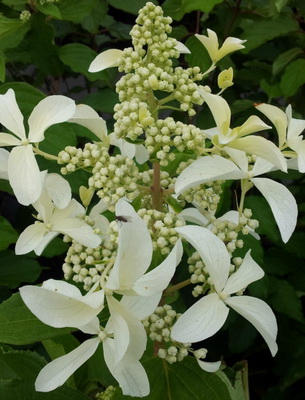
‘Great Star’ (‘Le Vasterival’)
The height of the bush is 2 m. The inflorescence is round, 15 cm in diameter. Among the fertile flowers are sterile, very large, white, in the form of a "propeller". Blooms until September.
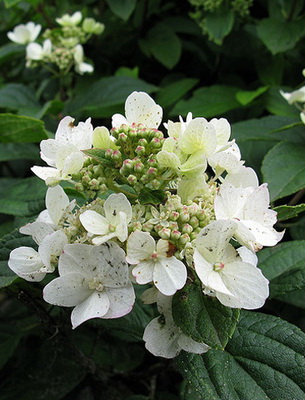
‘Dart’s Little Dot’ (‘Darlibo’)
The height of the bush is 0.8-1 m. The inflorescence is spherical, 15 cm in diameter, the flowers are white, sterile and fertile. Blooms until October.

‘Kyushu’
Bush height 3 m. Narrow-conical, loose inflorescence, 20-35 cm long, white flowers, sterile and fertile. Blooms until mid-August.
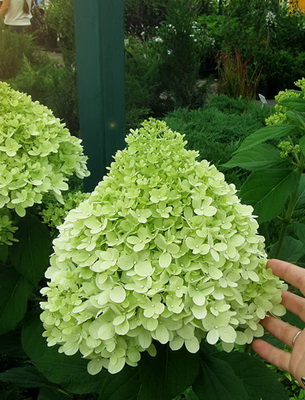
‘Limelight’
The height of the bush is 2.3 m. The inflorescence is broad-conical, 30 cm long, the flowers are sterile, light green, then white. This one of the best varieties of panicle hydrangeas for the Moscow region blooms until early October.
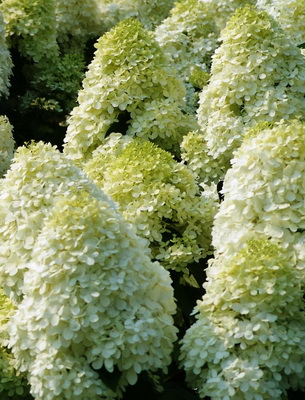
‘Mega Mindy’ (‘Ilvomindi’)
The height of the bush is 1.8 m. The inflorescence is conical, up to 30 cm long. Most of the flowers are sterile. The color is white, then red-pink. Blooms until August.
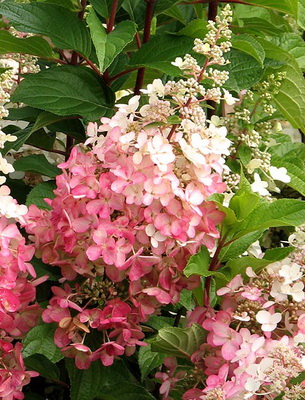
‘Pinky Winki’
The height of the bush is 1.6 m.As you can see in the photo, this panicle hydrangea has a conical inflorescence, 20 cm long:
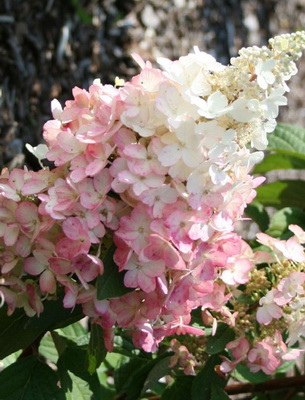
The flowers are sterile, white, then deep pink. It continues to bloom in October.
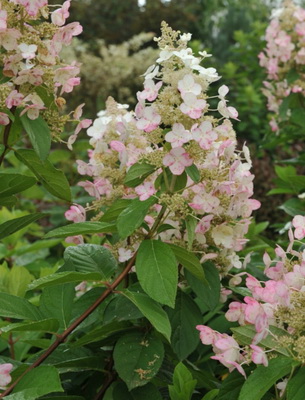
‘Pink Diamond’
The height of the bush is 2-3 m. The inflorescence is cone-shaped, up to 30 cm long. The flowers are sterile and fertile, white, then pink. It continues to bloom in October.
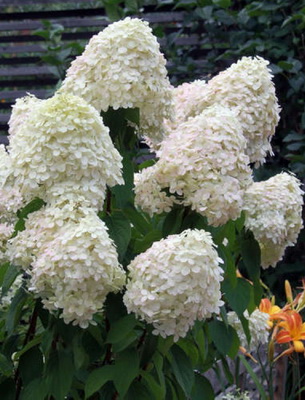
‘Phantom’
The height of the bush is 2 m.Look at the photo - this variety of panicle hydrangea has the largest inflorescence, conical-rounded, 30 cm long:
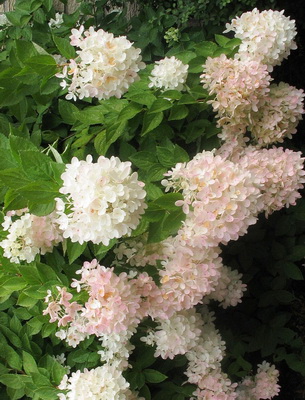
The flowers are sterile, white, then light pink. Blooms until October. Reminiscent of the 'Grandiflora' variety.
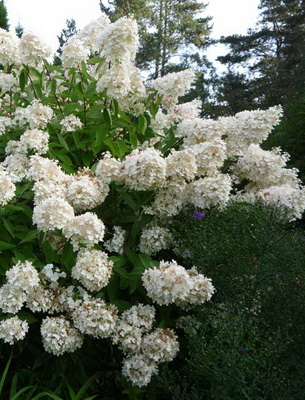
‘Floribunda’
The height of the bush is 2 m. The inflorescence is broad-conical, up to 40 cm long. The flowers are sterile and fertile, white. Blooms until October.
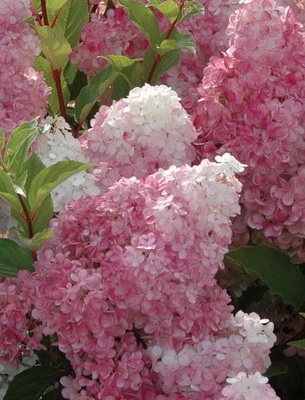
‘Vanille Fraise’ (‘Renhy’)
The height of the bush is 1.8 m. The inflorescence is broadly toxic, 30 cm long, the flowers are small, sterile, pale pink. This panicle hydrangea, recommended for the Moscow region, continues to bloom in October.
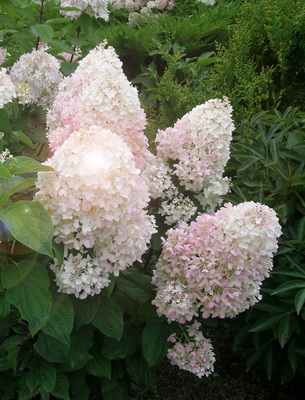
‘Silver Dollar’
The height of the bush is 1.7-4 m. The inflorescence is conical-rounded, up to 25 cm. The flowers are sterile, creamy white, then pink. It also blooms in October.
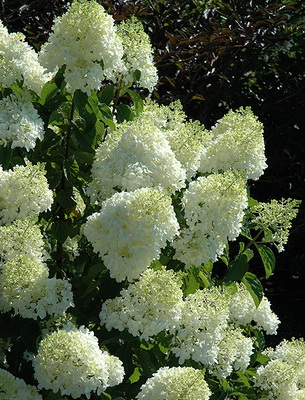
'Tardiva'
The height of the bush is 1.3-3 m. The inflorescence is conical, 25 cm long. The flowers are sterile and fertile, white. Blooms in October.
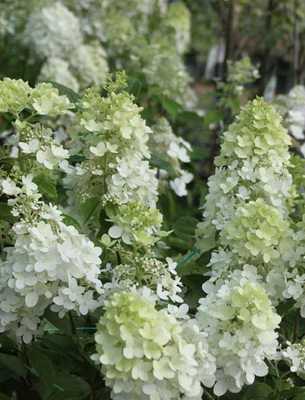
‘Unique’
The height of the bush is 2-3 m. The inflorescence is a wide cone, 25 cm long. One third of the flowers are small fertile, the rest are sterile, white, then intense red. In the garden, this panicle hydrangea blooms until September.
If you dig around the Internet, look into all kinds of forums, it becomes clear that ‘Limelight’ is in the lead in this list. It is followed by ‘Vanille Fraise’ (‘Renhy’) and ‘Phantom’, and perhaps ‘Grandiflora’ n ‘Kyushu’.
When describing the varieties of the best paniculate hydrangeas, one should not forget about especially fragrant forms. In theory, all hydrangeas, which have many fertile flowers, can be classified as fragrant. However, the aroma of the varieties is different and not always pleasant. It's good that at a distance, as a rule, you can't hear him.
However, there are varieties, as the advantages of which it is the aroma that is mentioned in the first place!
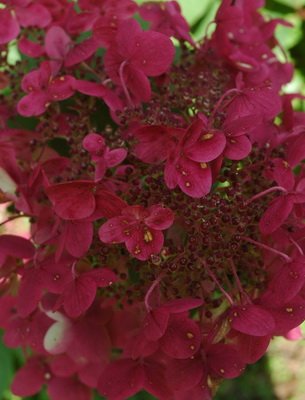
For example, ‘Wim’s Red’ and ‘Big Ben’ hydrangeas smell like honey.
Admire the photo of the best varieties of panicle hydrangeas for the Moscow region in these photos:
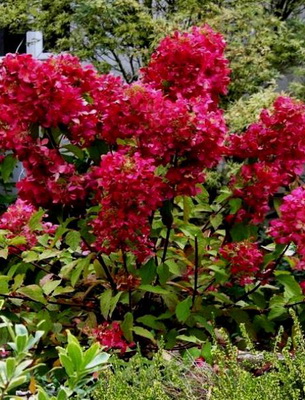
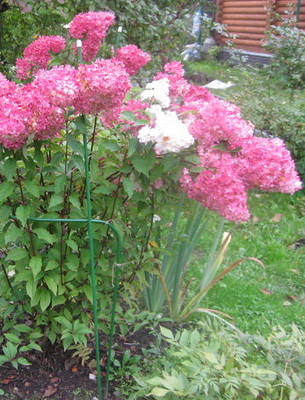

Varieties
Breeding work over decades has resulted in an excellent variety of Weigela varieties.
Especially attractive is the "Carnival", in which each bush has flowers of different colors. Early weigela grows up to 2 m. A crown of increased density is formed in it. In the spring and summer months, the foliage has a bright green color, towards the end of the growing season, ocher notes are found.
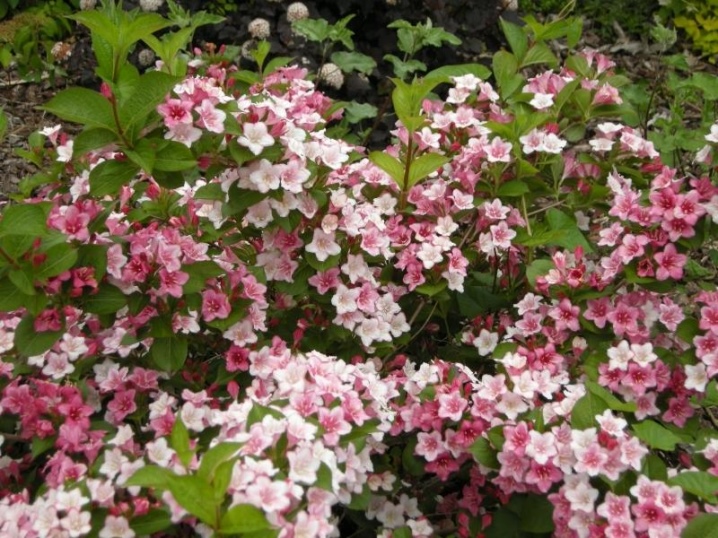
Due to the foliage and flowers, it is almost impossible to see the stems. Young shoots are covered with brownish and red bark. The flowering period takes an average of 20 days. The buds are distinguished by a delicate appearance and red-purple colors.
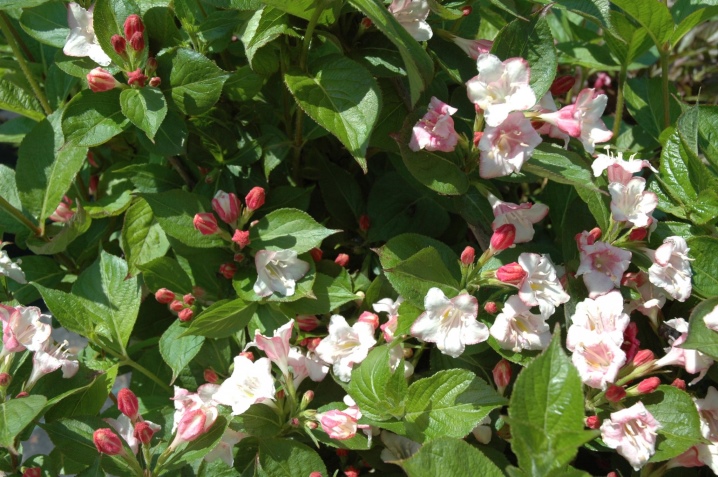
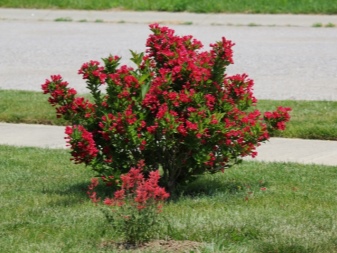
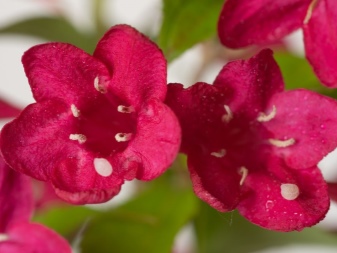
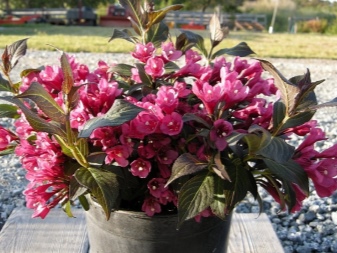
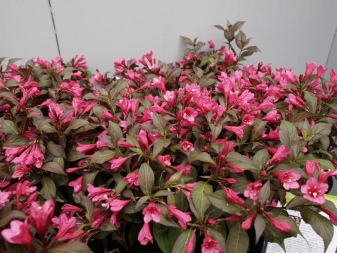
The buds of "Minor Black" bloom in the last days of spring and in the first decade of summer. The variety clearly prefers sun-drenched land, it develops poorly in shady areas.
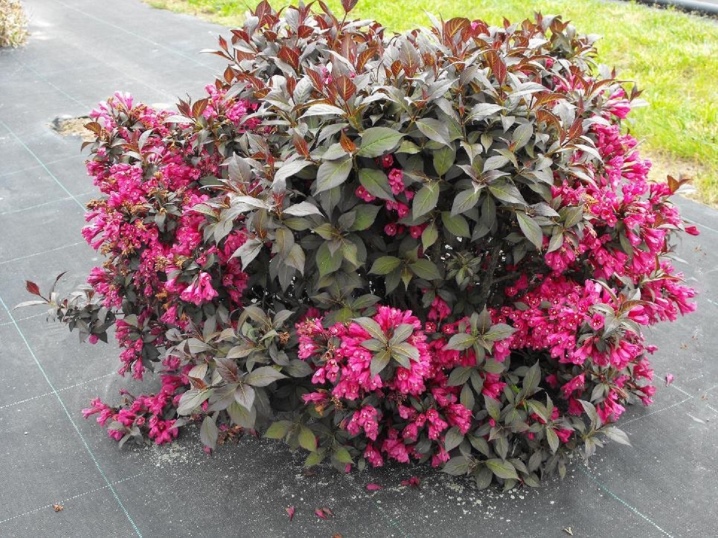
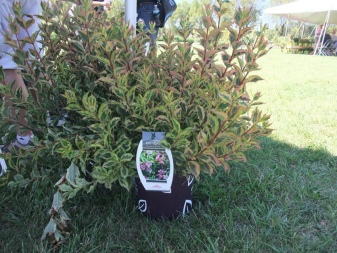
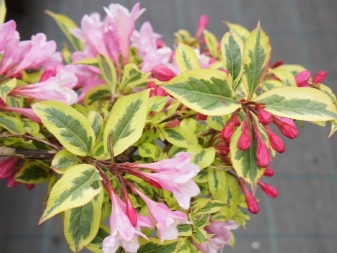
You can expect the appearance of pinkish buds at the "Magic Rainbow" in the first third of summer. Bushes can survive partial shade, but they need sun to thrive.
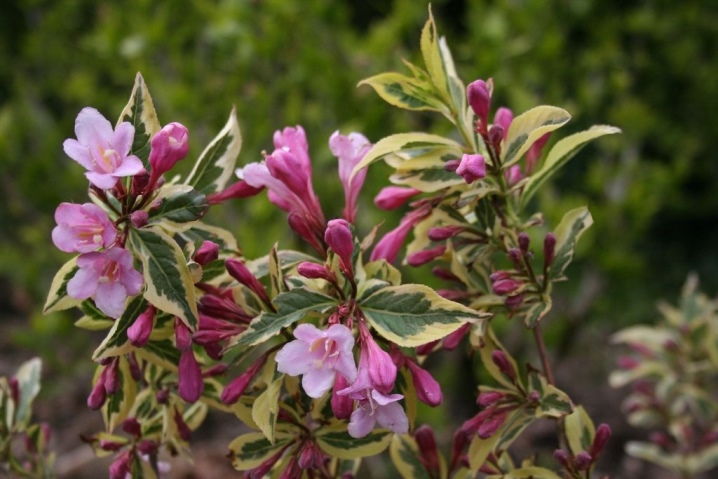

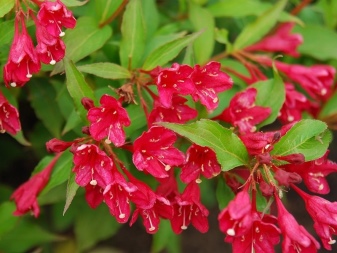
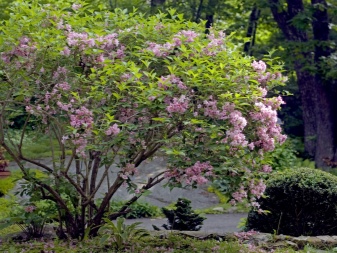
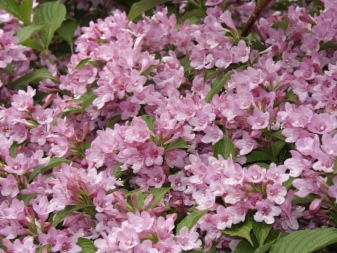
By the beauty of flowering, variegated weigela is deservedly distinguished.
The width of the flowers does not exceed 0.04 m.They can be both single and collected in clear groups. The bud is painted in a red-pink tone, along the edge of the petals are slightly lighter. Flowering continues in May and June. Under favorable conditions, you can expect the re-emergence of buds in the first days of September.
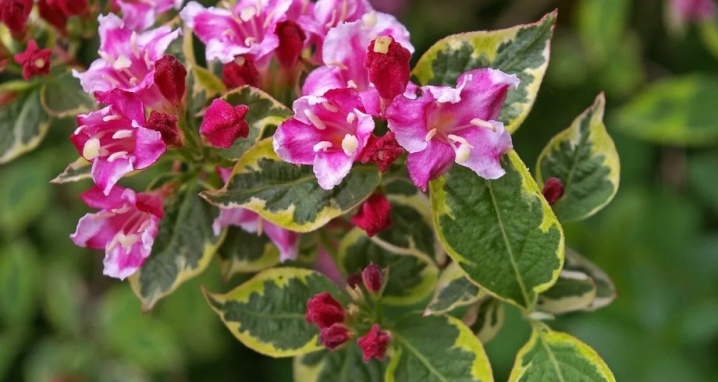
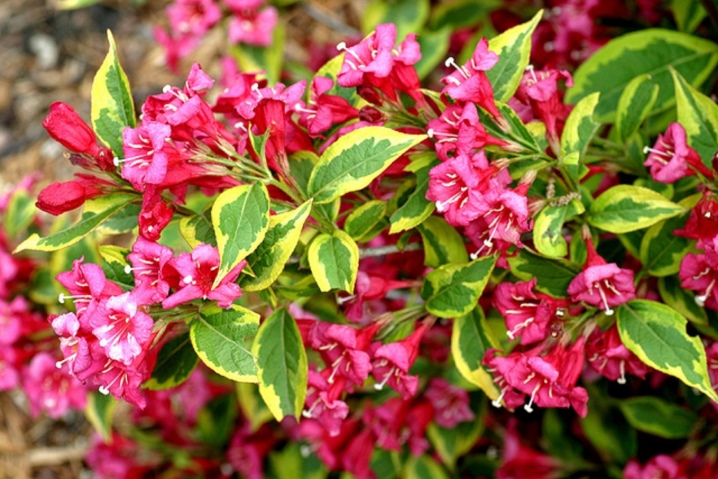

The flowers of the purple weigela are painted in a dark pink tone and have a yellowish center. Flowering covers June and July is quite abundant. Wintering is possible only with high-quality shelter. The plant can be used both in a decorative group and in a hedge.
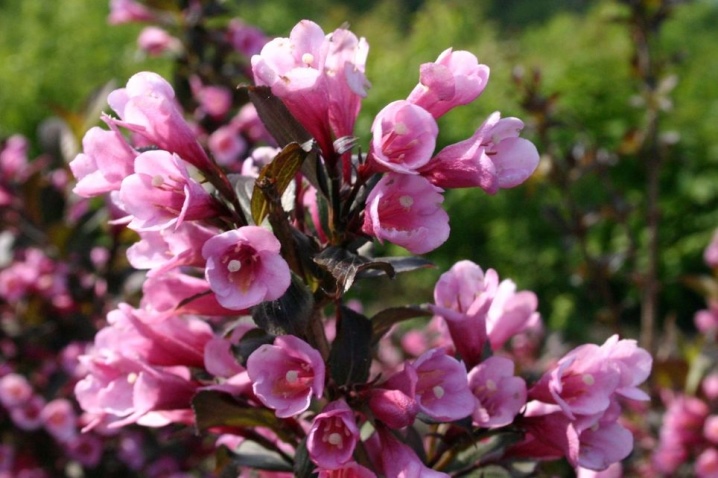
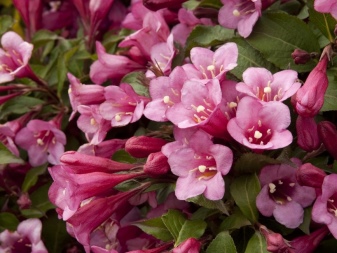
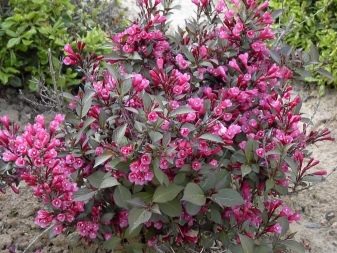

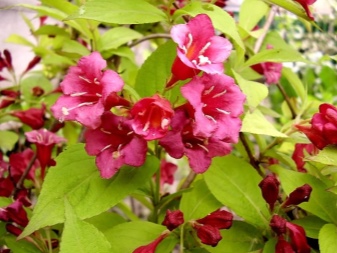
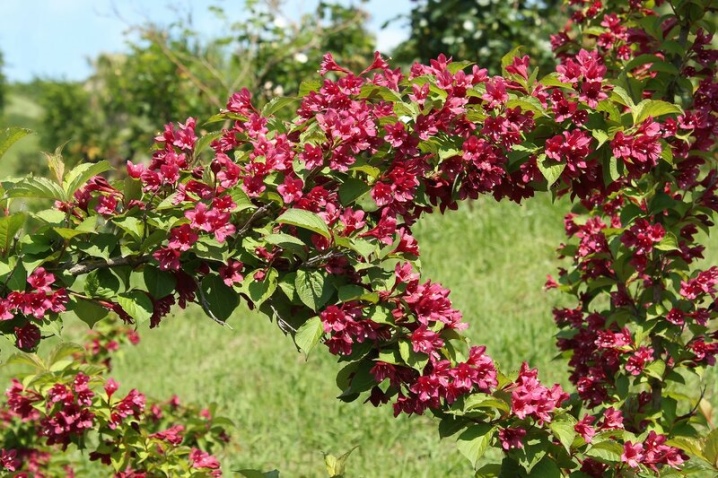
Although the plant loves the sun, if urgently needed, you can plant it in partial shade. The height and width of an adult bush are the same (1.2 m).



Description of the plant
Astilba (lat. Astilbe) is a perennial herb, belongs to the Saxifrage family. Scottish botanist Lord Hamilton gave the plant such a sonorous name, which in translation means - "without shine", that is, the foliage of astilbe is dull, matte, devoid of gloss.
Under natural conditions, representatives of the Saxifrage family can be found on the Japanese islands, in North America, and East Asia. Wild species prefer high humidity, therefore they grow along river banks in deciduous forests. The plant came to us from Japan at the end of the 18th century or at the beginning of the 19th. It was brought by von Siebold and Karl Thunberg - hunters for outlandish exotic plants. Since then, astilba has become a popular representative of shady gardens.
The aerial part of the perennial plant dies off for the winter. Depending on the species, the height of the flower varies from 10 cm to 2 m. The reddish-green or dark green foliage can be simple, twice and three times feathery, denticles are noticeable along the edges.
Astilba rhizome is interestingly arranged. Every year a new growth appears on it, that is, new buds are formed annually in the upper part of the rhizome, and its lower part gradually dies off over time. This leads to the fact that you have to constantly pour the earth under the plant, as the rhizome peeps out from under the ground.
Such a moment causes a lot of trouble for gardeners, since over time a significant mound in size is poured over the soil surface. However, such a feature, which causes inconvenience, does not stop plant breeders from replenishing the collection with new varieties, photos of which can be seen in the article and get acquainted with the most common astilbe.
Astilba blooms with apical inflorescences, consisting of openwork snow-white, pink, carmine, lilac and red star flowers. Different species differ in the time interval of flowering. Some varieties bloom in June, others delight the eye with pyramidal, rhombic or paniculate inflorescences in July, and still others in August. The types of astilbe with drooping inflorescences look interesting.
Planting and caring for large-leaved hydrangea
A gardener who decides to plant a large-leaved hydrangea must take into account the peculiarities of growing and caring for the crop.
Site selection is the first step in planting a seedling. The shrub requires 6 hours of sunshine, but not under the scorching sun, but preferably at the beginning or end of the day.
Due to the fragility of the roots, it is advisable to buy seedlings with a closed root system. Planting hydrangeas is best done in the spring, when a constant positive temperature is established.
Landing technology:
- The distance between the seedlings is made at least 1 m.
- A planting pit is prepared with a size of 40x40x40 cm or in proportion to the root system.
- To fill the pit, a mixture of turf, leafy earth and sand is prepared in equal proportions. The soil mixture can be diluted with peat, humus and needles.
- A plant with a lump of earth is placed in the center of the planting pit, sprinkled with prepared soil, and compacted.
- A young seedling is watered abundantly, and the near-stem circle is mulched with peat with the addition of compost in a layer of 7-10 cm.
Watering
|
The shrub is watered regularly throughout the season.The pH of the water for irrigation should not exceed 5.5. |
Some growers use a hydrogel to maintain proper moisture levels around the root system. This will help the soil stay moist longer, even with irregular watering. The hydrogel beads are added at planting or later in the trunk circle.
Top dressing
Top dressing of large-leaved hydrangea is carried out three times a year:
- in the spring after wintering to activate the forces for the growing season;
- before laying the buds, in mid-June;
- two weeks after the beginning of flowering.
For fertilization, coniferous soil, pine bark or overdried needles are used.
Pruning
Formative pruning is not carried out for 3 years after planting. A young plant needs time to grow.
If necessary, in April, sanitize and remove dried and frozen branches.
It is better to prune inflorescences in spring, old flowers will serve as additional shelter of flower buds from frost.
In remontant varieties, all branches can be shortened to 2-3 buds.
The number of branches removed should not exceed 1/4 of the total number of shoots.
Wintering and shelter of large-leaved hydrangea
In mid-September, remove all the lower leaves, with the onset of the first cold weather, remove the leaves to the middle of all branches.
To protect the shrubs from excess moisture during the rains, a shelter is made of plastic wrap so that the hydrangea goes for the winter with a moderate water content in the soil and with a dry crown.
At the end of October, before the onset of night frosts, the bushes are mulched with peat, one bucket per bush, form a hill and slightly compact it.
|
With the onset of stable cold weather, the branches are bent to the ground and fixed with metal brackets, covered with spruce branches. |
A layer of breathable covering material is placed over the spruce branches, which, in turn, is covered with dry litter.
The topmost layer is made waterproof, for example, a plastic wrap. The final stage is carried out with the onset of stable cold weather. Small holes are left for ventilation, which should be covered during severe frosts and opened with the onset of positive temperatures in winter.
In spring it is impossible to abruptly remove the shelter - the temperature drop is destructive for the flower buds. The layers are removed gradually in April, focusing on the weather. You can leave a bush without shelter if the weather has settled down with positive temperatures.
Conclusion
When choosing a variety for growing in Central Russia, it is necessary to take into account the indicators of winter hardiness of the culture, choose plants not only beautiful, but also the most adapted to specific regions and unfavorable winter conditions.
How to care for a weigela to grow a lush bush
When you have completed your spring planting, you should think about how to care for the weigela. There is nothing super complicated in this task. You just need to follow certain rules.
- First, be sure to water the seedling during dry periods. But if you were prudent and carried out the mulching procedure - covering the soil around the plant with a layer, for example, of bark - then you are not threatened with frequent watering.
- Secondly, you need to ensure that the area where the weigela grows remains clean: that is, it is necessary to regularly and very carefully weed out the weeds so as not to catch the root system of the bush.
- Third, do not forget to loosen the soil well.
If you follow all of the above instructions, you will soon achieve the result that you can see in the photo. flowering weigela bush:

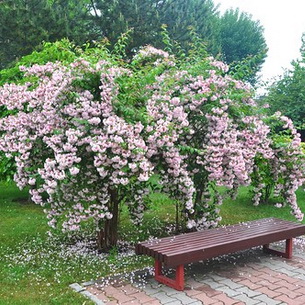
Of course, when wondering how to grow a weigela healthy and luxuriantly blooming, you immediately remember making nutritious dressings in the soil. True, if you have already done this in advance - you brought compost under the roots when planting - then you can safely forget about this moment for the next two years.But in the third year, you still have to work hard and in early spring it is imperative to fertilize the soil with minerals containing phosphorus, nitrogen and potassium. This will ensure the growth of young shoots and leaves.
We must not forget that it will help to achieve the desired result, which you can appreciate if you look at the photo below, caring for the weigela shrub, which involves feeding in late May or early June:
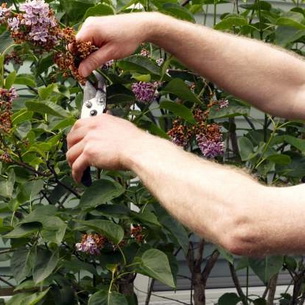
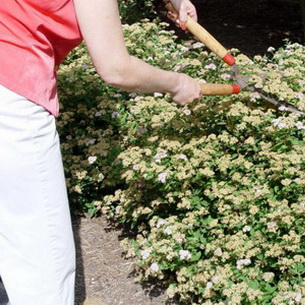
It is then that the buds form in the plant.
Therefore, fertilizers must necessarily contain potassium and phosphorus. This will help extend the flowering period and make it truly gorgeous.
But the third time you need to pay special attention to fertilizing the bushes before the autumn digging. Then wood ash should be added to the soil 200g / m2
Be sure to sprinkle it with earth so that a mound forms, an area around the plant, when all the leaves have already fallen from it. This moment will come around the end of October or early November. In addition, bend the bush branches to the ground and press them against it, and cover with spunbond or roofing felt on top. All this is done in order to protect the weigela from the coming winter frosts.
Remember, in order to achieve the effect that you see in the photo, care and cultivation of weigel is necessary in accordance with the rules and procedures that we described to you:
